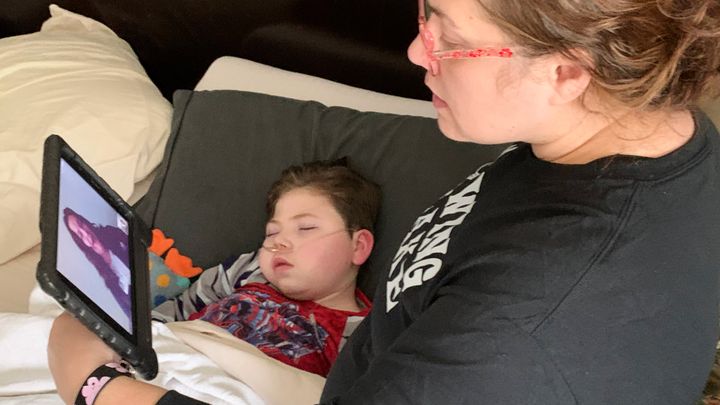
DETROIT ― The COVID-19 pandemic is wrenching people apart and forcing them to communicate from afar, creating chasms of isolation for families who have lost, or are about to lose, a loved one ― whether it’s due to the disease or other causes.
“It’s one of the heartbreaking things about this,” said Marti Coplai, chief executive officer of Angela Hospice in Livonia, Michigan. “It’s a hard time to be born right now and a hard time to die. The normal supports we count on aren’t available to us.”
Telephone calls, text messages and Zoom meetings aren’t the same as seeing a loved one in person for the last time. Neither are Zoom memorial services, one of the tools people have come up with to grieve. Others will drive by homes to honk or wave, put up white or blue ribbons, finding new ways to offer comfort after a loss.
“You can’t replace a hug,” said Coplai.
The pandemic is “a new day’’ for the hospice movement, said Karen Monts, director of grief support services for Hospice of Michigan, a statewide organization with 1,100 patients. “We need to find new ways to socially connect with each other.”
Most hospice care, which relieves pain and provides support for terminal patients, has been provided in patients’ homes or in assisted living centers and nursing homes, not hospitals. But to prevent further spreading the virus, hospice organizations have been forced to pull back nearly all staff from in-home and community settings and are now conducting some care with new telemedicine apps, electronic devices and support groups.
Hospice workers help patients near death by creating quiet, dim environments free of loud, disturbing noises; talking to them in soothing tones; using soft music and gentle touches; and keeping their mouths moist.
“Things like holding hands if you can, certain smells and familiar aromas, music are helpful,’’ said Monts. “You need to create a sacred space around that person. I encourage people to surround a person with love and calls, and to come together as a family.”
Patients who are hospitalized or in hospice facilities are still benefiting from hospice services, social workers say. But because of the pandemic, nurses are largely doing the palliative care once performed by hospice workers in hospital settings. Angela Hospice and some other programs are maintaining their own small in-patient facilities.
Hospice workers may hold phones to a patient’s ear “even in unresponsive patients,” said Katharine Smith, a Detroit-area hospice social worker. “I’ve seen evidence that people can hear right up to the end. It also gives comfort to the person calling.”
Hospice staff are also instructed to address dying patients as if they might recover.
“There are stories of patients not conscious who at later time rallied, woke up, and said, ‘I could hear what you guys were saying.’ We train all our staff [to] proceed as if they can hear you,’’ said Michael Paletta, chief medical officer at Hospice of Michigan.
Virtual hospice programs were becoming increasingly common even before the pandemic. Three years ago, Angela Hospice began a tablet-based “virtual assistant” program to facilitate interactions.
“You press a button and it makes a call to Angela Hospice,” Coplai said. “Some people don’t want it. Others appreciate it. We were showing one woman in her 90s how it works and she rolled her eyes and said, ‘It’s just like Skype.’”
Amy Etmans Huschka — a mother in Bloomfield Hills, Michigan, who has used Angela Hospice services for five years for her son, Martin — said the addition of telemedicine services has been an important help in emergencies when she has immediate questions.
Martin, 6, is one of only 16 people in the world with a genetic neurological condition known as TRAPP C 4, which attacks his brain. He is non-verbal, immobile and has lost the ability to swallow. His doctors considered his condition terminal as a baby, making him eligible for hospice care, and he has out-lived everyone’s predictions.
Huschka uses the agency’s tablet to contact her son’s nurse for quick assessments to determine when he needs to see a doctor. During the pandemic, she is also using telemedicine to consult her son’s social worker.
She said Martin has actually been less sick and needed fewer antibiotics in the last three weeks because he isn’t out in the community. “I want to keep healthy and not expose him to the coronavirus; telemedicine helps us do that,’’ she said.
“It’s a big help,” she said, adding that one shouldn’t wait until the last few days of a person’s life to make use of hospice services. “Do it yesterday. They can provide comfort and resources for you and your loved ones.”
Telemedicine is a very different way to provide hospice care, Coplai said, as the philosophy is based on providing in-person physical and emotional support. There are challenges, too, in communicating with hospitalized patients who can’t speak because they are unconscious, sedated, on a ventilator, or just too exhausted.
“It’s heartbreaking to see and hear about people who are dying without their loved ones at their side,’’ Monts said.
People who have lost someone to the pandemic also need to look out for themselves. “It’s important to find someone to talk to, she said. “Give pain a voice. It may help somebody else.”
“Human kindness comes out of tragic things, and that’s a great thing. Unfortunately, it sometimes takes a tragedy to do that sometimes.”
CORRECTION: A previous version of this story misspelled Karen Monts’ last name.
- Stay up to date with our live blog as we cover the COVID-19 pandemic
- What you need to know about face masks right now
- How long are asymptomatic carriers contagious?
- Lost your job due to coronavirus? Here’s what you need to know.
- How to switch off from work when home is your office
- 8 sleep tips if coronavirus anxiety is keeping you up at night
- How long does coronavirus live in the air?
- The HuffPost guide to working from home
- What coronavirus questions are on your mind right now? We want to help you find answers.
- Everyone deserves accurate information about COVID-19. Support journalism without a paywall — and keep it free for everyone — by becoming a HuffPost member today.
